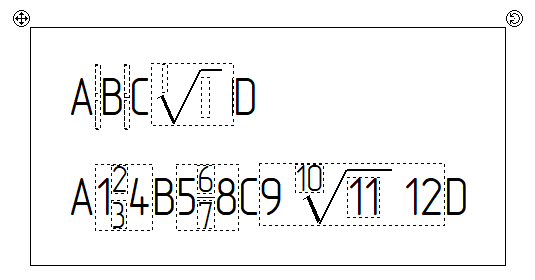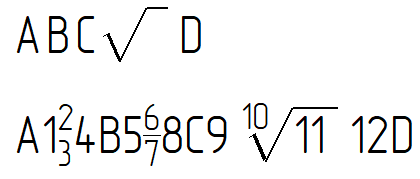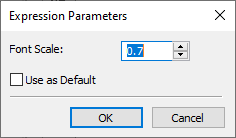Inserting Indexes, Fractions and Radicals into Text |
  
|
The insertion of indexes, fractions and radicals into the text (except for string text) is carried out according to the same principle. The insert command adds a template of the appropriate type to the text. The template consists of three cells.
In the text content editing mode, the contours of the template cells are indicated by dashed lines. The figure below shows the index, fraction and radical inserted into regular text and describes the contents of each cell.

The first line is empty templates;
The second line is filled templates
A, B, C, D - regular text
1 - text before the index;
2 - top index (superscript);
3 - bottom index (subscript);
4 - text after the index;
5 - text before the fraction (integral part);
6 - numerator;
7 - denominator;
8 - text after the fraction;
9 - text before the radical;
10 - root degree;
11 - root expression;
12 - the text after the radical.
Cell outlines are not displayed outside of the text content editing mode.

The text cursor can be moved between cells using the arrows on the keyboard or set to the necessary cell by clicking ![]() on it. The contents of the cells are entered using the keyboard or using the contextual menu. You can insert indexes/fractions/radicals into the cells of other indexes/fractions/radicals.
on it. The contents of the cells are entered using the keyboard or using the contextual menu. You can insert indexes/fractions/radicals into the cells of other indexes/fractions/radicals.
Font Parameters can be set individually for individual characters in each cell in the same way as for regular text. The size of the content in the cells before and after the index/fraction/radical, as well as in the cell of the root expression, is equal to the font size. The size of the content in the cells of the upper and lower indexes, numerator, denominator and root degree is equal to the product of the font size and scale.
For all types of text, except string, there are two ways of insertion:
For string text, you can only insert fractions using a separate command described in the section Contextual Menus of Input Boxes.
When editing the text content in a 2D or 3D view window, insertion with default scale is performed using the following contextual menu commands:
•Insert ![]()
![]() Index <Alt>+<F12>;
Index <Alt>+<F12>;
•Insert ![]()
![]() Fraction <Ctrl>+<F12>;
Fraction <Ctrl>+<F12>;
•Insert ![]()
![]() Radical;.
Radical;.
Commands for inserting indexes and fractions are also available in the automenu:
|
<Alt>+<F12> |
Insert Index |
|
<Ctrl>+<F12> |
Insert Fraction |
When editing the text content in the editor, commands for inserting indexes, fractions and radicals with a default scale are available on the Standard toolbar, as well as in the Insert section of the drop-down menu.
After calling the command, the template is immediately inserted into the text. The default scale can be adjusted when inserting with custom scale.
When editing the text content in a 2D or 3D view window, insertion with custom scale is performed using the following contextual menu commands:
•Insert ![]()
![]() Index;
Index;
•Insert ![]()
![]() Fraction;
Fraction;
•Insert ![]()
![]() Radical.
Radical.
Commands for inserting indexes and fractions are also available in the automenu:
|
|
Insert Index... |
|
|
Insert Fraction... |
When editing the text content in the editor, commands for inserting indexes, fractions and radicals with custom scale are available in the Insert section of the drop-down menu.
After calling any of the listed commands, the Expression Parameters dialog box appears, in which you can set the Font Scale. After clicking OK, a template with the specified scale will be inserted into the text.
If the Use as Default checkbox is enabled, then after clicking OK, the entered scale value becomes the default scale. Despite the same appearance of this dialog for indexes, fractions and radicals, they have separate default scales.
